Related Research Articles
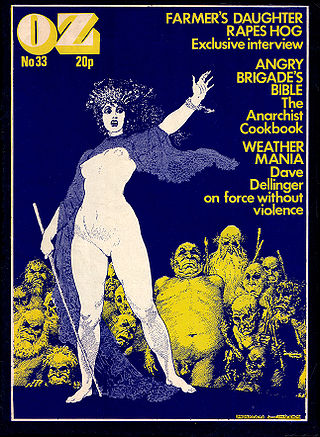
The terms underground press or clandestine press refer to periodicals and publications that are produced without official approval, illegally or against the wishes of a dominant group. In specific recent Asian, American and Western European context, the term "underground press" has most frequently been employed to refer to the independently published and distributed underground papers associated with the counterculture of the late 1960s and early 1970s in India and Bangladesh in Asia, in the United States and Canada in North America, and the United Kingdom and other western nations. It can also refer to the newspapers produced independently in repressive regimes. In German occupied Europe, for example, a thriving underground press operated, usually in association with the Resistance. Other notable examples include the samizdat and bibuła, which operated in the Soviet Union and Poland respectively, during the Cold War.
The Underground Press Syndicate (UPS), later known as the Alternative Press Syndicate (APS), was a network of countercultural newspapers and magazines that operated from 1966 into the late 1970s. As it evolved, the Underground Press Syndicate created an Underground Press Service, and later its own magazine. For many years the Underground Press Syndicate was run by Tom Forcade, who later founded High Times magazine.

The Oracle of the City of San Francisco, also known as the San Francisco Oracle, was an underground newspaper published in 12 issues from September 20, 1966, to February 1968 in the Haight-Ashbury neighborhood of that city. Allen Cohen (1940–2004), the editor during the paper's most vibrant period, and Michael Bowen, the art director, were among the founders of the publication. The Oracle was an early member of the Underground Press Syndicate.
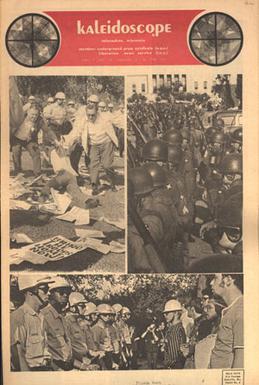
Kaleidoscope was an underground newspaper that was published in Milwaukee, Wisconsin, USA]. Founded by John Kois, the radio disk jockey Bob Reitman and John Sahli, it was published from October 6, 1967, to November 11, 1971, printing 105 biweekly issues. The paper's first issue was printed with a borrowed $250 in an edition of 3,500 copies, which sold out in two days.

Jeff Sharlet (1942–1969), a Vietnam veteran, was a leader of the GI resistance movement during the Vietnam War and the founding editor of Vietnam GI. David Cortright, a major chronicler of the Vietnam GI protest movement wrote, "Vietnam GI, the most influential early paper, surfaced at the end of 1967, distributed to tens of thousands of GIs, many in Vietnam, closed down after the death of founder Jeff Sharlet in June, 1969."

The Chicago Seed was an underground newspaper published biweekly in Chicago, Illinois from May 1967 to 1974; there were 121 issues published in all. It was notable for its colorful psychedelic graphics and its eclectic, non-doctrinaire radical politics. Important events covered by Seed writers and artists were the trial of the Chicago Eight, Woodstock, and the murder of Fred Hampton. At its peak, the Seed circulated between 30,000 and 40,000 copies, with national distribution.
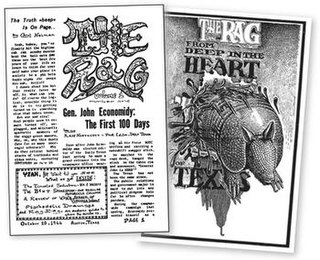
The Rag was an underground newspaper published in Austin, Texas from 1966–1977. The weekly paper covered political and cultural topics that the conventional press ignored, such as the growing antiwar movement, the sexual revolution, gay liberation, and the drug culture. The Rag encouraged these political constituencies and countercultural communities to coalesce into a significant political force in Austin. As the sixth member of the Underground Press Syndicate and the first underground paper in the South, The Rag helped shape a flourishing national underground press. According to historian and publisher Paul Buhle, The Rag was "one of the first, the most long-lasting and most influential" of the Sixties underground papers. In his 1972 book, The Paper Revolutionaries, Laurence Leamer called The Rag "one of the few legendary undergrounds."

The Washington Free Press was a biweekly radical underground newspaper published in Washington, DC, beginning in 1966, when it was founded by representatives of the five colleges in Washington as a community paper for local Movement people. It was an early member of the Underground Press Syndicate. Starting in December, 1967 they shared a three-story house in northwest Washington with the Liberation News Service, the Washington Draft Resistance Union, and a local chapter of the anti-draft group Resistance. A print shop was in the basement, and other activist groups used the space and got their mail there. The paper's original founders and editors included Michael Grossman, Arthur Grosman and former State Department computer programmer William Blum, but the staff went through many changes and by 1969 nobody on the paper was even acquainted with any of the original founders.

Quicksilver Times was an antiwar, counterculture underground newspaper published in Washington, DC. Its first issue was dated June 16, 1969, with Terry Becker Jr., a former college newspaper editor and reporter for the Newhouse News Service, the main instigator in the founding group of antiwar activists. It ran for 3 years, with its final issue appearing in Aug. 1972. Publication was irregular and during the latter part of its run it was publishing once every 3 weeks. It was a member of the Liberation News Service and the Underground Press Syndicate. Quicksilver Times was one of several anti-government underground papers of the period now known to have been infiltrated by government informants.
Willamette Bridge was an underground newspaper published in Portland, Oregon from June 7, 1968, to June 24, 1971. In the spring of 1968, several groups of people in Portland were discussing starting an "underground" newspaper in Portland, similar to the Los Angeles Free Press or the Berkeley Barb. They were partially motivated by a frustration with the reporting in the mainstream press, which was still supporting the Vietnam war, opposing progressive movements like the United Farmworkers Union, and showed no understanding at all of the growing "Counterculture" and its music, dress and mores. On the other hand, they saw many things going on in the city that were positive, but isolated- Antiwar activity at Reed College, "Hippies" gathering around Lair Hill park, the progressive wing of the Democratic Party gathering strength, craft stores and head shops opening around town, local bands like The Great Pumpkin and The Portland Zoo giving concerts. A newspaper could bring these groups together and break the information monopoly of the daily papers.

Space City! was an underground newspaper published in Houston, Texas from June 5, 1969 to August 3, 1972. The founders were Students for a Democratic Society veterans and former members of the staff of the Austin, Texas, underground newspaper, The Rag, one of the earliest and most influential of the Sixties underground papers. The original editorial collective was composed of Thorne Dreyer, who had been the founding "funnel" of The Rag in 1966; Victoria Smith, a former reporter for the St. Paul Dispatch; community organizers Cam Duncan and Sue Mithun Duncan; and radical journalists Dennis Fitzgerald and Judy Gitlin Fitzgerald.

Hundred Flowers was an underground newspaper published in Minneapolis, Minnesota from April 17, 1970 to April 4, 1972. It was produced by a communal collective, with the main instigator being antiwar activist and former Smith College drama instructor Ed Felien. The 16-page, two-color tabloid was published weekly and cost 25 cents, circulating about 5,000 copies.
Pittsburgh Fair Witness was a radical counterculture underground newspaper published in Pittsburgh, Pennsylvania from 1970 to 1973. The first 9 monthly issues were published starting in February 1970 under the title Grok. Beginning with vol. 1, no. 10 the title was changed to Pittsburgh Fair Witness and the paper shifted to publication once every three weeks; starting with the Dec. 3–17, 1971 issue it published on a biweekly schedule until its demise with vol. 4, no. 6. The PFW was staff-owned and published by a collective that called itself "The Commune." An editorial published in the May 26, 1972 issue under the heading "Our Rap" gives the paper's statement of purpose:
"The Fair Witness is published by a non-profit collective and is dedicated to the worldwide movement of people to control themselves—the movement to break down the authoritarian systems of government that are denying us our basic freedoms, that are responsible for needless genocidal wars, the perpetration of minority discrimination, the pollution of our environment and our bodies, the high concentration of power among the wealthy classes, exploitation of the individual, etc. The paper is dedicated to the struggle of all peoples to gain back the right to their own lives, the struggle to raise the consciousness of the world as a whole, the struggle to become independently productive through a working knowledge of the tools at our disposal. As a local paper our most important function concerns the movement here in western Pennsylvania."

Leviathan was a New Left radical underground newspaper published in a tabloid newspaper format and distributed through the underground press network in the US in the years 1969-1970. Fairly serious in content with a focus on radical organizing issues, it was loosely aligned with the SDS movement. The first issue was dated March, 1969, with two editorial offices in New York, where Carol Brightman, Beverly Leman, and Kathy McAfee were listed on the first masthead, later to be joined by a number of others including Marge Piercy and Sol Yurick; and San Francisco, where the collective included Peter Booth Wiley, Carole Deutch, Danny Beagle, Matthew Steen, Bob Gavriner, Al Haber, Bruce Nelson, Todd Gitlin and David Wellman. Part of the inspiration for the paper was a desire to fill the gap created by the demise of the influential New Left organ Studies on the Left, and the core group included people from the antiwar newsletter Viet Report.

GI's Against Fascism was a small but formative organization formed within the United States Navy during the years of conscription and the Vietnam War. The group developed in mid-1969 out of a number of sailors requesting adequate quarters, but coalesced into a formal organization with a wider agenda: a more generalized opposition to the war and to perceived institutional racism within the U.S. Navy. Although there had been earlier antiwar and GI resistance groups within the U.S. Army during the Vietnam era, GI's Against Fascism was the first such group in the U.S. Navy. The group published an underground newspaper called Duck Power as a means of spreading its views.

GI coffeehouses were a consequential part of the anti-war movement during the Vietnam War era, particularly the resistance to the war within the U.S. military. They were mainly organized by civilian anti-war activists as a method of supporting antiwar and anti-military sentiment among GIs, but many GIs participated as well. They were created in numerous cities and towns near U.S. military bases throughout the U.S as well as Germany and Japan. Due to the normal high turnover rate of GIs at military bases plus the military's response which often involved transfer, discharge and demotion, not to mention the hostility of the pro-military towns where many coffeehouses were located, most of them were short-lived, but a few survived for several years and "contributed to some of the GI movement's most significant actions". The first GI coffeehouse of the Vietnam era was set up in January 1968 and the last closed in 1974. There have been a few additional coffeehouses created during the U.S. led wars in Iraq and Afghanistan.
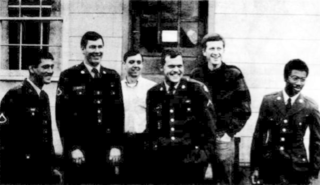
The Fort Lewis Six were six U.S. Army enlisted men at the Fort Lewis Army base in the Seattle and Tacoma, Washington area who in June 1970 refused orders to the Vietnam War and were then courts-martialed. They had all applied for conscientious objector status and been turned down by the Pentagon. The Army then ordered them to report for assignment to Vietnam, which they all refused. The Army responded by charging them with "willful disobedience" which carried a maximum penalty of five years at hard labor. The six soldiers were Private First Class Manuel Perez, a Cuban refugee; Private First Class Paul A. Forest, a British citizen from Liverpool; Specialist 4 Carl M. Dix Jr. from Baltimore; Private James B. Allen from Goldsboro, North Carolina; Private First Class Lawrence Galgano from Brooklyn, New York; and Private First Class Jeffrey C. Griffith from Vaughn, Washington. According to the local GI underground newspaper at Fort Lewis, this was the largest mass refusal of direct orders to Vietnam at the base up to that point in the war. Their refusal and subsequent treatment by the Army received national press coverage.

The GI Underground Press was an underground press movement that emerged among the United States military during the Vietnam War. These were newspapers and newsletters produced without official military approval or acceptance; often furtively distributed under the eyes of "the brass". They were overwhelmingly antiwar and most were anti-military, which tended to infuriate the military command and often resulted in swift retaliation and punishment. Mainly written by rank-and-file active duty or recently discharged GIs, AWOLs and deserters, these publications were intended for their peers and spoke the language and aired the complaints of their audience. They became an integral and powerful element of the larger antiwar, radical and revolutionary movements during those years. This is a history largely ignored and even hidden in the retelling of the U.S. military's role in the Vietnam War.
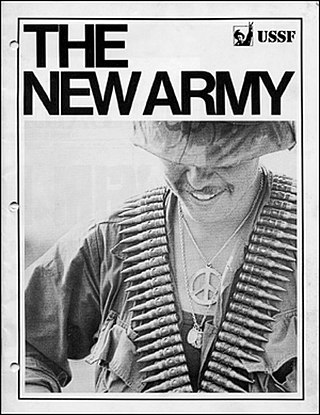
The United States Servicemen's Fund (USSF) was a support organization for soldier and sailor resistance to the Vietnam War and the U.S. military that was founded in late 1968 and continued through 1973. It was an "umbrella agency" that funded GI underground newspapers and GI Coffeehouses, as well as providing logistical support for the GI antiwar movement ranging from antiwar films and speakers to legal assistance and staff. USSF described itself as supporting a GI defined movement "to work for an end to the Viet Nam war" and "to eradicate the indoctrination and oppression that they see so clearly every day."
References
- ↑ About this newspaper: The Big Us Chronicling America. The Library of Congress. Retrieved October 20, 2010.
- ↑ The Encyclopedia of Cleveland History Retrieved October 20, 2010.